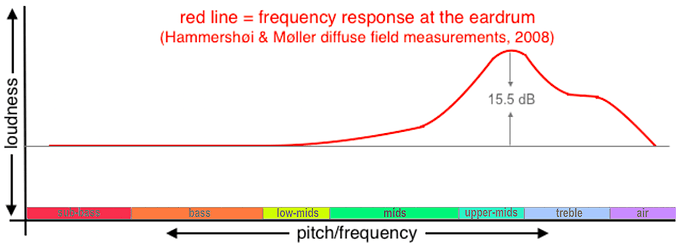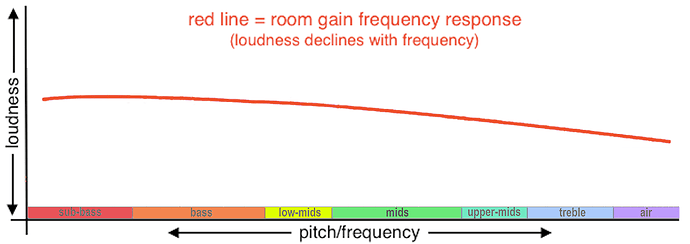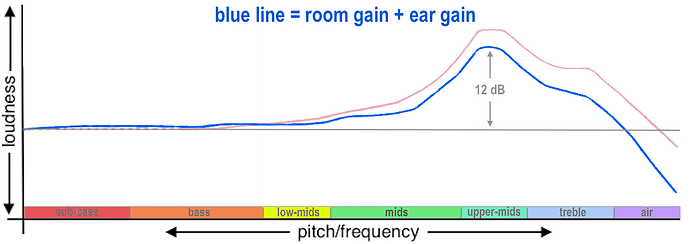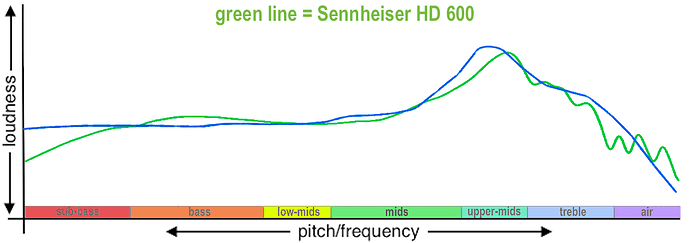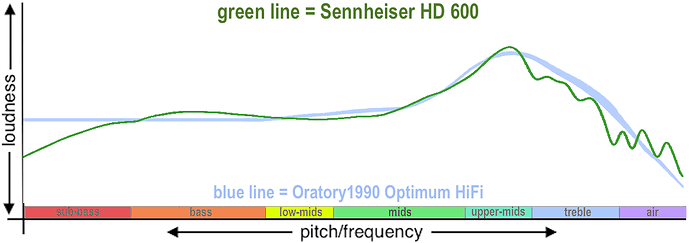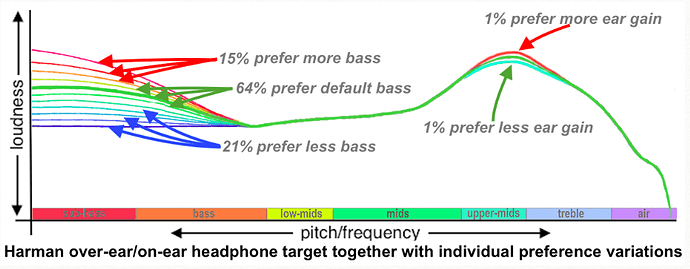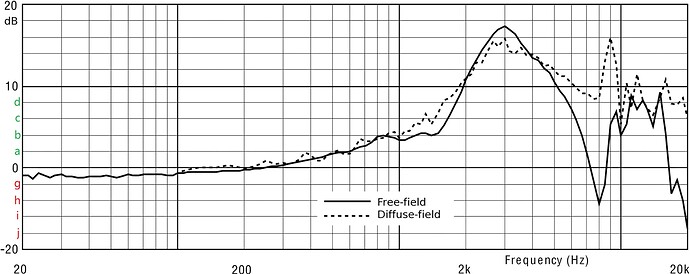Yeah mate I do look at them… I guess it gives you and idea of what the manufacture was sonically aiming for?
On Apple products you are so restricted and limited software wise. Windows OS is much more open regarding software but restricted regarding OS itself. Linux is completely open but not all commercial softwares are supported.
If you are more knowledgeable and more tech savvy, stay away from Apple.
Mac versus PC – that takes me back about 20 years!
I knew this but I’m not at all familiar with the Diffuse-field curve - what’s that?
The two key types here are diffuse and free. Keep in mind that all of this is based on speakers in a room.
Basically diffuse field is the result of sound waves bouncing off walls, so some of them cancel each other out, and reinforce each other, etc.
Free field is the result of only the direct sound, and assumes no reflections or sound waves bouncing off other surfaces.
I was working on the following when John_W_Clark posted the (correct) answer, but maybe this will still be of interest to anyone willing to go a bit further down the rabbit hole:
We can measure the frequency response from bass to treble of room loudspeakers simply by putting a microphone in front of them. But we can’t do the same for headphones because they need to be flush-mounted to a human head to function properly. The listener’s head is where the microphone needs to be. So instead we can insert a tiny probe microphone into a listener’s ear canal to measure the sound arriving right in front of the ear drum.
Diffuse field means equal loudness of sound coming at your ears from all directions simultaneously. The goal is to measure equal loudness sound at the ear drum to see how the sound arriving at the ear drum differs from equal loudness sound before it enters the ear.
What we find is that the shape of the outer ear + ear canal acts as a natural amplifier – but only of high frequencies:
By the middle of the 1990s it had become fashionable to design headphones that attempted to reproduce this response curve (for example, the AKG 501). These sounded shrill, even painful, at louder listening levels, but this is what a naive understanding of the theory said should be accurate, so many people convinced themselves that this is indeed how headphones should sound.
In fact, however, it’s only the outdoor world that sounds anywhere close to diffuse field. Indoor sounds, including music venues, are the result of the initial sound source plus sound reflections off the walls, furnishings, etc. These reflections have the opposite effect to what our ears provide. They amplify the bass frequencies rather than the mids and highs.
The following curve, called the Brüel & Kjær Optimum HiFi is the result of measuring many concert venues both large and small. It shows how lower frequencies are louder than higher frequencies in acoustically excellent spaces. (The word gain = amplification and is typically used in this context):
When you combine this room amplification with the diffuse field ear amplification you get the kinder, gentler curve we see in the blue line in this graph:
Sennheiser may have been the first to realize that room gain needed to be factored in as well as ear gain. In the 1990s they released first the HD 580 then later the HD 600 which nearly matched this second curve:
However, they marketed these and subsequent models as simply being diffuse field tuned, making no mention of the critical room amplification adjustment that they actually included. The HD 600 is still sold and valued for its natural/accurate frequency response to this day.
In fact, the HD 600 is more nearly neutral than the last graph shows. Here is another version showing the HD 600 against the latest thinking on headphone accuracy:
In this graph the blue line abandons diffuse field. Instead, it combines very sophisticated measurements of an accurate loudspeaker taken at the ear drum and including the ear drum’s own response but done without any room gain influence. The resulting frequency response is combined with the Brüel & Kjær room gain curve we saw in the second graph above. (BTW, Brüel & Kjær is pronounced broil & care.)
The upshot of all this is that these days when someone describes a headphone as diffuse field tuned, they in fact most likely mean diffuse field plus room gain. And ultimately they’re simply trying to specify a headphone with an appropriate amount of ear gain but with no boost in the bass.
When “FLAT” was the goal, then one should take the inverse of that graph and tune their headphone to that inverse (raised Bass, lower Treble). Or am I being dumb here?
Neither deaf nor dumb, grin. You’re simply noticing an important point that I didn’t include. Thanks to the magic of psychoacoustics our brains extract the faint extra detail in the upper mids and treble that this ear amplification provides. Then it does some further processing and feeds an UN-amplified version of the signal to our conscious minds. IOW, the inversion you mention is done by the signal processing activity of the brain.
The problem is that the brain expects to find ear gain in the signal. So if you were to listen to a signal that was actually flat by the time it reached the ear drum, what you’d hear would be an upper mids plus treble deficient sound. The brain would have removed too much loudness from that region of the audio signal.
That would produce a “net flat” line.
I am pretty sure most of us would think it sounds bad / weird / wrong.
It is interesting that most of our differences in how we like tonality tend lie in the shape of the curve around that upper-mid peak, and what we think should or should not be happening in the bass or sub-bass region. Almost all preferences can be expressed in those two points.
Also huge kudos to @MaynardGK for the super detailed trip down the rabbit hole, thanks for the background and history. Thanks !!
Funny that we all talk about the HD600. Also note the reason the SHP9500 is so popular is that it is basically a budget version of the HD600 that is more comfortable. Obviously they aren’t quite the same sound quality, but the frequency responses are very similar, and they even have the same rolled off bass.
Agree. What blows my mind is how little disagreement the Harman testing found in upper-mids preference:
While bass preference covered a wide range.
I mean, you can always rely on confirmation bias and cherry picking to show their ugly head in studies.
Or you gather enough data so any arbitrary correlation can be found. Example by Matt Parker
20 years ago PC world was so different, as a software engineer I told you just pure facts.
Free-field is measuring the response of a speaker in front of a dummy head in anechoic chamber but since headphones cover the ear, sound reach the ear from all directions and diffuse-field curve is the attempt to simulate that.
Since (almost) all major contents (famous songs, movies…) are recorded in stereo format (not binaural) they meant to be played in a pair of speakers (stereo format) spaced 60 degrees from each other. The Harman curve is the attempt to make headphones sound like a pair of studio speakers in front of you in a studio.
One thing I notice a lot of people miss is Harman curve specifies the bass boost is subjective and you should adjust the bass level based on your own preferences. So any complain about the bass in Harman curve is pointless, use the bass boost in the Harman curve just as the starting point.
I was about to extract numbers from the chart above but then I noticed something, in the y axis 0 to -20 distance is half of 0 to 20
I am pretty sure positive numbers are linear, so:
a = 2 , b = 4 , c = 6 , d = 8
But I’m not sure whether negative numbers are linear and:
g = -4 , h = -8 , i = -12 , j = -16
Or they are logarithmic.
Maybe it’s just a typo?
Does anybody know?
you can always rely on confirmation bias and cherry picking to show … Or you gather enough data so any arbitrary correlation can be found.
All of which may be true, but in this case I actually suspect the Harman research is correct. There are endless disagreements that take the form of whether headphone A is too bright at treble frequency X or not. But these almost always tend to centre around spikes that exceed the Harman ear gain curve. The only common exception I see is in loudly played music where electric guitars are routinely being played up the neck or similar high notes are being reached by synth. Here people tend to prefer a few dB less ear gain.
The reason I find this surprising is that the ear gain curve is exactly where the wide differences from person to person in outer and inner ear shapes show up as measurable amplification variations at the eardrum. Apparently, just another case of brain data massage in action.
Amen to this! Sean Olive is perennially alienating much of the headphone enthusiast community by pushing the 6 dB boost as reference neutral without mentioning the range of variance in the results. And to what end? Not many open back headphones have been tuned to anything like the Harman target. So far as I can tell for open back you can have an accurate mid-range or you can have a big bass (and especially sub-bass) boost, but you can’t have both. Even within Harman, this is divisive. The JPL sub-division as a brand targets the youth market and mainly makes lower priced closed backs, so no problem. But the AKG sub-division has a history of open back products emphasis.
I see you cross-posted this interesting free field graph question on Reddit and got a reply straight from the horse’s mouth [that it’s likely a typo].
![]() Yup, there are not too many people better than oratory1990 to ask headphone related questions and fortunately he is nice enough to respond fast. In fact I not only respect him (so much), I like him too.
Yup, there are not too many people better than oratory1990 to ask headphone related questions and fortunately he is nice enough to respond fast. In fact I not only respect him (so much), I like him too.
